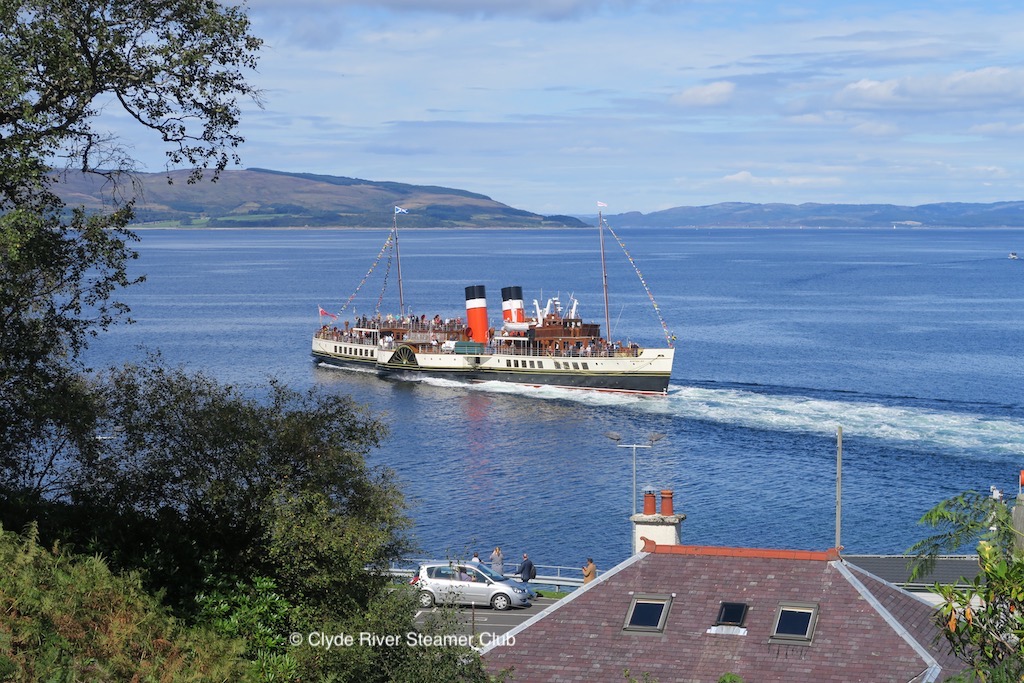Andrew Clark assesses the latest crisis to befall Waverley.
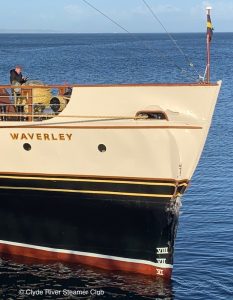
Waverley’s bow after the collision with the concrete ramp at the head of Brodick pier. The full extent of the damage is not yet known
It was all going so well. Waverley Excursions Ltd (WEL) had not only attracted unprecedented moral and financial support throughout last year’s boiler refit appeal, but also emerged from the COVID-19 lockdown with a certificate to carry passengers. The paddler’s recovery seemed little short of a miracle.
Such is Waverley’s popularity, and such was the skill and dedication shown by her new managers, that by the middle of August she was ready to sail again, her complement limited by the pandemic to 220. In the first week-and-a-half of her short cruise programme she proved she was back in business. Most sailings sold out. She performed well and looked fantastic — reassuring all who had kept faith with her, defying those who doubted her survival and encouraging her management to extend the season by a week.
Then, at 1650 on Thursday afternoon, she literally hit the buffers, colliding with the concrete ramp at the shore end of Brodick pier after what appeared to be a loss of astern power. The jolt was so sudden and strong that a number of people were thrown to the deck. One woman had to be airlifted to hospital on the mainland. Around 20 others suffered injuries. Most passengers were in a state of shock.
The dent in the ship’s bow was the least of it. The reputational damage was huge as the story raced through the media: everyone with an ill-informed opinion speculated wildly about cause and consequence. Waverley’s comeback season, so full of promise, had ground to a halt.
Let’s set aside the loss of revenue and the daunting prospect of yet more fundraising, on top of the considerable expense of another winter overhaul. The biggest concern is what the regulatory authorities may say when they complete their report. Waverley has survived several potentially fatal blows in her 45 years of active preservation. Well, here we go again.
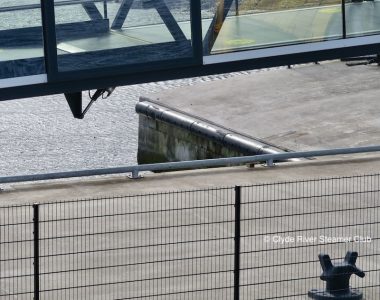
The rubber-straked concrete ramp (centre) at the end of the east-facing berth of Brodick’s new finger pier, photographed from Isle of Arran at the link span berth
But yes, before the bow struck concrete, everything was going so well. At midday on Thursday I joined the ship at Largs. The sun was out. There was a fresh westerly breeze. The funnels and varnished handrails were gleaming. Even in the face of social distancing, the mood on board seemed cheery as we set off down the Largs Channel, opting for the sheltered eastern side of Wee Cumbrae, before heading out to open sea with the expanse of Arran’s glorious contours before us. It felt like Clyde cruising at its best.
Ticketing arrangements were such that Greenock passengers had to disembark at Brodick, enabling WEL to maximise revenue with a healthy influx of Arran passengers for the cruise through Lamlash Bay and past Pladda to the south end of Arran. On our return, there was time to detour to Corrie before approaching the non-linkspan berth on the seaward side of Brodick’s new finger-shaped pier.
Contrary to some reports, the paddler was not ‘going too fast’ as she came in. She needed momentum to counter a gusty offshore wind, which could easily have thrown her off the berth if she had been going slower.
At that moment, standing at the starboard rail on the foredeck, I couldn’t help noticing she had not gone full astern as the concrete ramp drew near. Crash! I nearly lost my balance in the jolt but, like most around me, steadied myself and began to ponder the consequences.
Nothing I saw or heard in those moments bore out the exaggerations spouted by certain individuals on social media and national news. In fact, as people picked themselves up, the reality of the situation was how calm everyone was and how coolly and professionally the crew reacted.
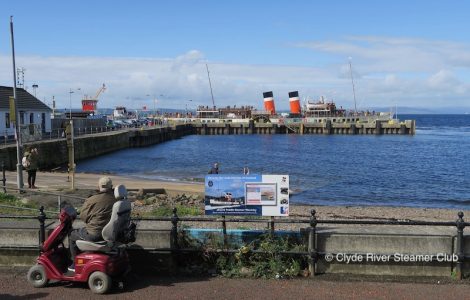
Before it all happened: Waverley picked up her Largs passengers shortly after midday before proceeding to Brodick and Pladda
Public service announcements came quickly and clearly. The foredeck was vacated. Deckhands handed out bottles of water. Two doctors on board gave assistance. Bandages were produced, the injured identified and attended to. Emergency services arrived on the pier in what seemed like record time. We were instructed to gather in the fore and aft saloons on the main deck and then, 15 minutes later, ushered into the ferry terminal’s soon-to-be crowded departure lounge, outside which two fire engines, an ambulance, the coastguard vehicle and police cars had gathered. It was a well-rehearsed operation.
This was no consolation for the 200 or so Waverley passengers. CalMac staff were already engulfed in a tortuous situation, after the cancellation of afternoon sailings by Caledonian Isles due to a linkspan breakdown at Ardrossan. There was to be one crossing by Isle of Arran, leaving Brodick at 1920 — passengers only (just over 100 under pandemic restrictions and limited to those already booked).
It was fortunate that Paul Semple, WEL’s general manager, was on board Waverley as purser. Calm and collected, Paul was made for this sort of situation. After consulting Captain Stephen Colledge and contacting emergency services, he issued a brief media statement and asked CalMac about the possibility of an emergency late-evening sailing to Ardrossan.
To its credit, CalMac came to the rescue. Caledonian Isles, which had already been sent to Troon to disgorge the cars stranded on board by the Ardrossan linkspan failure, returned there to put the pilot ashore and continued to Brodick, where she was due to spend the night. Instead, she picked up Waverley’s passengers and landed them at Ardrossan shortly before midnight (though I and a handful of others opted, while the situation was still fluid, to remain on Arran and phone around for a bed).
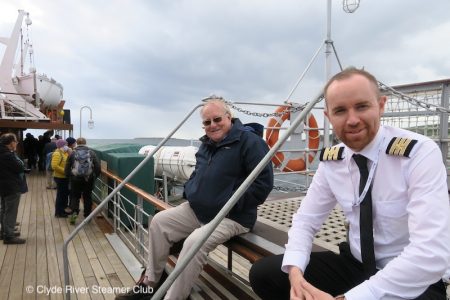
Paul Semple (right), pictured en route to Pladda on Thursday with Douglas McGowan, who was involved in a similar crisis when Waverley struck the Gantock rocks off Dunoon in July 1977
Taking a leaf out of former purser Jim McFadzean’s book, Paul had meanwhile arranged buses to transport everyone back to Largs and Greenock after midnight.
Since January 2019, when he and WEL chairman Cameron Marshall took responsibility for the paddler’s management, Paul and his team have changed the culture of Waverley, giving the whole operation a solid foundation for future development. They won £1m worth of support from the Scottish Government. They dealt honestly and openly with the Maritime and Coastguard Agency (MCA), the key regulatory authority.
At short notice they devised a timetable for a 2020 mini-season that was cleverly calibrated to maximise revenue and minimise risk.
This ‘can do’ positivity transmitted to the ship itself: the atmosphere on board over the past fortnight was palpably people-friendly, unlike some occasions in the recent past.
These two weeks of sailings were designed as a ‘shakedown’ — to iron out post-refit quirks, to prove to the MCA that the new management was capable of running the ship, to say ‘thank you’ to her many supporters, and convey the message that Waverley was once again ready for the world.
Beyond a return to Garvel Dry Dock to repair the bow, it is too early to speculate on Waverley’s future. Clyde steamer history is littered with groundings, collisions, human error, mechanical failure.
Thursday’s incident does not alter the fact that, aside from that dent in her bow, Waverley is in better shape than she has been for years. The Marine Accident Investigation Branch will make its findings known. Mechanical failure can be rectified. The WEL board will devise a recovery strategy.
The priority must be to do whatever is necessary to get the ship back in service next summer. The support is there. The money must be raised. The world’s last seagoing paddle steamer offers an experience like no other. In her moment of greatest need, we must not let her down.
Andrew Clark is editor of the CRSC magazine ‘Clyde Steamers’ and author of ‘Pleasures of the Firth: Two Hundred Years of the Clyde Steamers’ (Stenlake, 2012) and other shipping books.
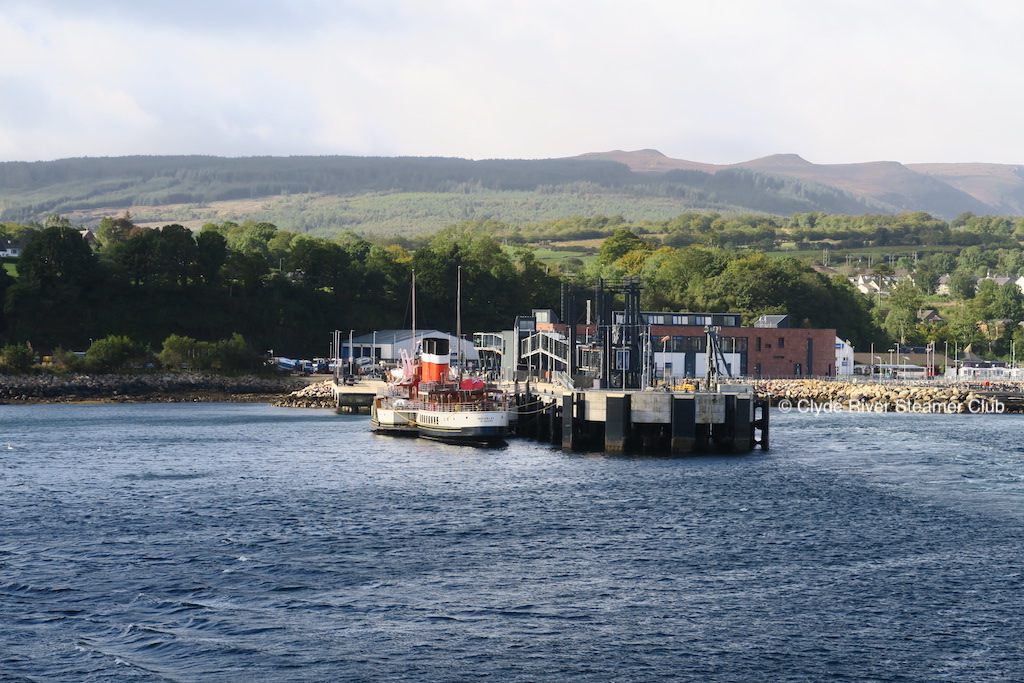
A forlorn Waverley lies at Brodick on Friday morning. If this had been a traditional pier like Keppel or Kilcreggan, the paddler would simply have gone past the face of the pier instead of colliding with the concrete ramp at the end
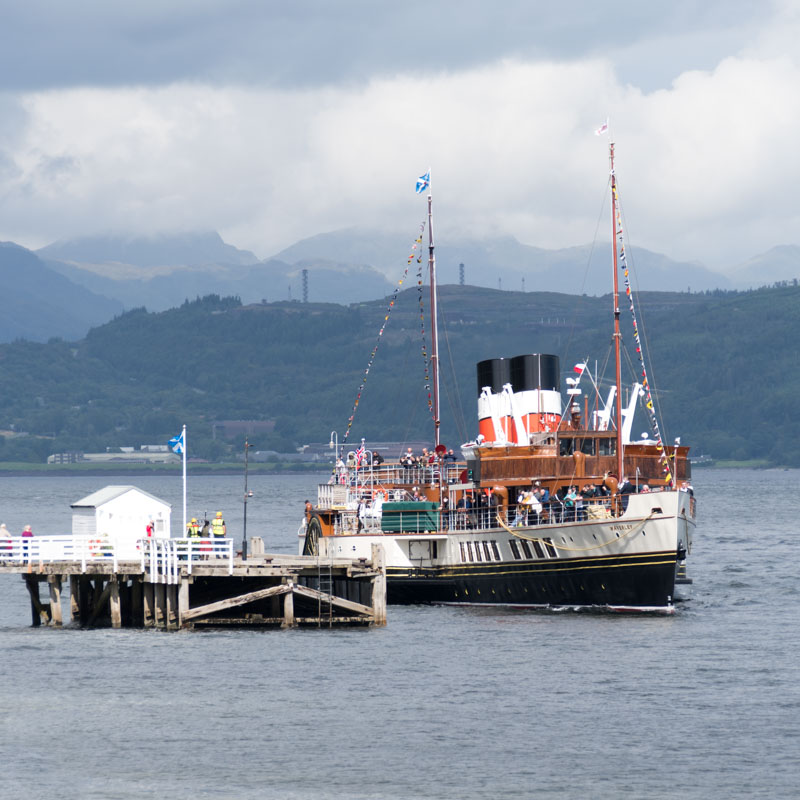
On her first public sailing of 2020 (22 August), Waverley visited Blairmore — as she did on her maiden voyage on 16 June 1947. Copyright John Newth
Published on 6 September 2020












